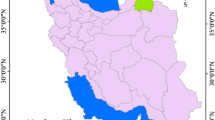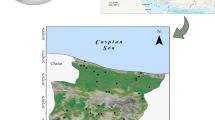Abstract
Accurate prediction of forest fire spread is very essential for minimizing its effects. Although many models have been developed to predict the forest fire spread, all these models require several parameters, sometimes, cannot be obtained in a real time. In this paper, the grey system theory was applied for forest fire spread model developing. By preprocessing and fusing the MODIS remote sensing data, the sequence data of the grey model can be confirmed. After making precision comparison among least square estimation algorithm, least square interpolation algorithm and ER algorithm, forest fire spread GM(1, 1) model was developed with ER algorithm and precision of the model was evaluated at the same time. The results showed that the fitting precision and predicting precision of the model were both high, of which the one-level model made up 50%, the two-level 25% and the model between the one-level and the two-level 25%. The prediction accuracy of forest fire spreading model was tested to meet the requirement of modeling. GM(1, 1) model provided a new approach for the study of forest fire spread simulation.

Similar content being viewed by others
References
Chang Y, Zhu Z, Feng Y, Li Y, Bu R, Hu Y (2016) The spatial variation in forest burn severity in Heilongjiang Province, China. Nat Hazards 81:981–1001
Quintano C, Fernández-Manso A, Roberts DA (2013) Multiple endmember spectral mixture analysis (MESMA) to map burn severity levels from Landsat images in Mediterranean countries. Remote Sens Environ 136:76–88
Sun T, Zhang L, Chen W, Tang X, Qin Q (2013) Mountains forest fire spread simulator based on geo-cellular automaton combined with Wang Zhengfei velocity model. IEEE J Sel Top Appl Earth Obs Remote Sens 6:1971–1987
Zheng Z, Zeng Y, Li S, Huang W (2016) A new burn severity index based on land surface temperature and enhanced vegetation index. Int J Appl Earth Obs Geoinf 45:84–94
Yuan CM, Wen DY (2000) Outline of forest fire behavior research. World For Res 13(6):27–31
Du JH, Tian XR (2012) Forest fire spreading model and its application. For Fire Prev 2:31–34
Perry GLW (1998) Current approaches to modeling the spread of wildland fire: a review. Prog Phys Geogr 22:222–245
Dupuy JL (1999) An analysis of semi-empirical and physical models for fire spread in wildland fuels. In: Eftichidis G, Balabanis P, Ghazi A (eds) Proceedings of the Advanced Study Course on Wildfire Management. Algosystems S.A., Athens, pp 419–438
Andre JCS, Viegas DX (1994) A strategy to model the average fireline movement of a light to medium intensity surface forest fire. In: Proceedings of the 2nd International Conference on Forest Fire Research, Coimbra, pp 221–242
Weber RO (2001) Wildland fire spread models. In: Johnson EA, Miyanishi K (eds) Forest fires behaviour and ecological effects. Academic Press, San Diego, pp 151–169
Pastor E, Zarate L, Planas E, Arnaldos J (2003) Mathematical models and calculation systems for the study of wildland fire behaviour. Prog Energy Combus Sci 29:139–153
Mell WE, Manzello SL, Maranghides A (2006) Numerical modeling of fire spread through trees and shrubs. In: Proceedings of the International Conference on Forest Fire Research, Figueira da Foz
Pitts WM (1991) Wind effects on fires. Prog Energy Combust Sci 17:83–134
Beer T (1991) Bushfire rate-of-spread forecasting: deterministic and statistical approaches to fire modeling. J. Forecast 10:301–317
Halada L, Weisenpacher P (2005) Principles of forest fire spread models and their simulation. J Appl Math Stat Inf 1(1):3–13
Glasa J, Halada L (2008) On elliptical model for forest fire spread modeling and simulation. Math Comput Simul 78(1):76–88
Zhao FA (2017) Review of wildland fire spread modelling. World For Res 30(2):46–50
Oldehoeft R (2000) Taming complexity in high-performance computing. Math Comput Simul 54:314–357
Artés T, Cortes A, Margalef T (2016) Large forest fire spread prediction: data and computational science. Proc Comput Sci 80:909–918
Fu ZQ, Sun QH, Cai YL, Dai EF (2002) Research on forecasting model of forest fire based on grey system theory. Sci Silvae Sin 38(5):95–100
Deng JL (1982) Control problems of grey systems. Syst Control Lett 5:288–294
Deng JL (1982) Grey control system. J Huazhong Univ Sci Technol 3:9–18
Liu SF (1999) Grey system theory and its application. The Science Publishing Company, Beijing, pp 117–122
Zheng Z, Huang W, Li S, Zeng Y (2017) Forest fire spread simulating model using cellular automaton with extreme learning machine. Ecol Model 348(348):33–43
Acknowledgements
Financial support for this study was provided through the Fundamental Research Funds for the Central University (2015ZCQ-LX-01), National Natural Science Foundation of China (No. 41401650). We are grateful to the undergraduate students and staff of the Laboratory of Forest Management and “3S” technology, Beijing Forestry University.
Author information
Authors and Affiliations
Corresponding author
Rights and permissions
About this article
Cite this article
Lv, C., Wang, J. & Zhang, F. Forest fire spread model based on the grey system theory. J Supercomput 76, 3602–3614 (2020). https://doi.org/10.1007/s11227-018-2560-x
Published:
Issue Date:
DOI: https://doi.org/10.1007/s11227-018-2560-x




